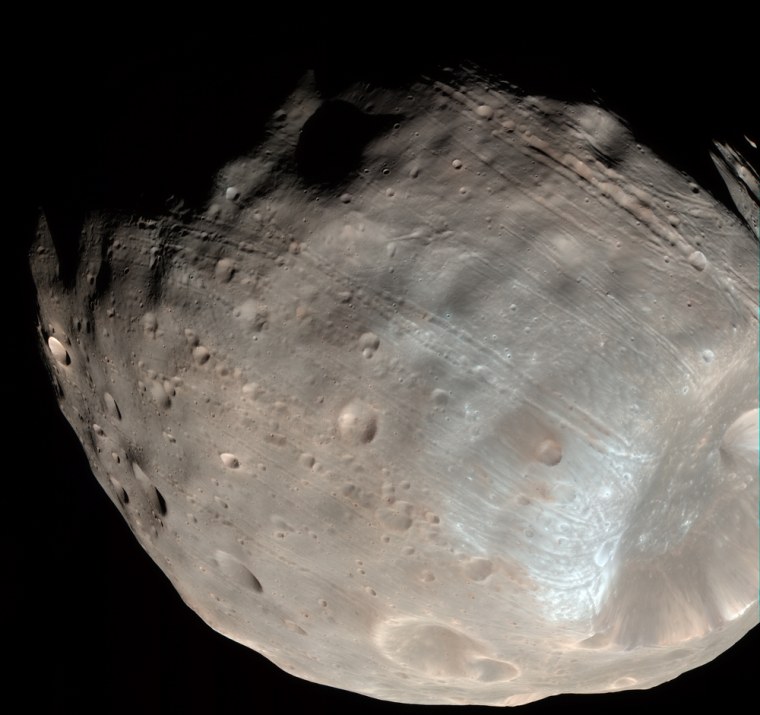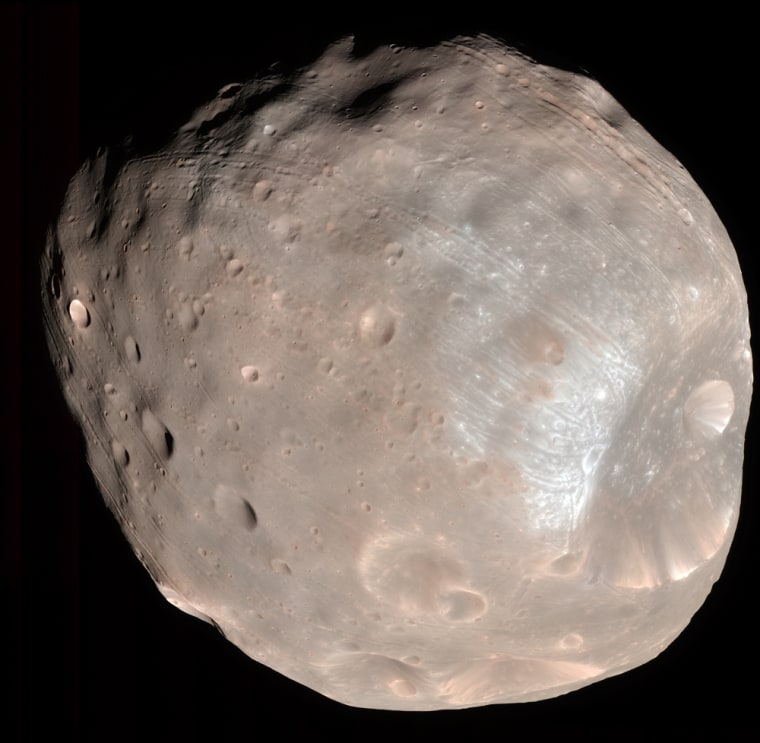NASA's Mars Reconnaissance Orbiter has captured new imagery, in color and in 3-D, of a target that may be almost as much of a scientific hot spot as the Red Planet itself: Phobos, the larger of Mars' two tiny moons.
The pictures were taken on March 23 by the orbiter's High Resolution Imaging Science Experiment, or HiRISE, and released on Wednesday. Phobos is expected to be the focus of an ambitious Russian-Chinese space mission scheduled for launch next year.
"Phobos is of great interest because it may be rich in water ice and carbon-rich materials," Alfred McEwen, principal investigator for the HiRISE camera at the University of Arizona's Lunar and Planetary Laboratory, said in a NASA image advisory.
Phobos has been the subject of orbital imagery since the days of the Viking orbiters in the 1970s, and some spacecraft have taken higher-resolution pictures of the moon because they flew closer, said Nathan Bridges, a HiRISE team member at NASA's Jet Propulsion Laboratory.
"But the HiRISE images are higher quality, making the new data some of the best ever for Phobos," Bridges said in Wednesday's advisory. "The new images will help constrain the origin and evolution of this moon."
What the colors indicate
Mars Reconnaissance Orbiter follows a track ranging from 155 to 196 miles (250 to 316 kilometers) above the Red Planet. The imagery was captured as the orbiter flew beneath the 13.5-mile-wide (22-kilometer-wide) moon, at a distance of 3,600 to 4,200 miles (5,800 to 6,800 kilometers). Two pictures, taken 10 minutes apart, were combined to produce a 3-D stereo view. (The 3-D effect requires the use of red-blue glasses.)
By combining information from the camera's blue-green, red and near-infrared color filters, scientists confirmed that material around the rim of Phobos' largest surface feature, Stickney Crater, appears bluer than the rest of Phobos.
The impact that excavated the 5.5-mile-wide (9-kilometer-wide) Stickney Crater is thought to have almost shattered the moon.

"Based on analogy with material on our own moon, the bluer color could mean that the material is fresher, or hasn't been exposed to space as long as the rest of Phobos' surface has," Bridges said.
The new view also shows landslides along the walls of Stickney and other large craters; Phobos' surface grooves and crater chains; and craters hidden on the moon's dark side illuminated by "Marsshine."
Marsshine is sunlight reflected by Mars onto the moon. The phenomenon is similar to "Earthshine," where Earth reflects sunlight that illuminates the dark side of our moon. Like Earth's moon, Mars' moons Phobos and Deimos are tidally locked on their planet — that is, they always present the same side to the planet they orbit.
The future for Phobos
Next year's Russian-Chinese mission, known as Phobos-Grunt ("Phobos-Soil" in Russian), is due to send an unmanned probe to Phobos to collect some of the moon's soil and bring it back to Earth for analysis. The mission may also include a Chinese Mars orbiter as well as two Finnish-Russian mini-landers that would be sent down to the Martian surface.
Phobos-Grunt is currently scheduled for launch in October 2009, with arrival at Mars set for August or September of 2010 and the return of the Phobos samples scheduled for 2012.
Scientists believe that Phobos and Mars' smaller moon, the 7.5-mile-wide (12-kilometer-wide) Deimos, may have been interlopers from the carbon-rich Mars-Jupiter asteroid belt that were captured in Mars orbit. The moons, discovered in 1877, take their names from the twin Greek gods of fear and terror.
Phobos has occasionally been mentioned as a preliminary target for manned missions to the Red Planet.
This report includes information from NASA. For more imagery, check the Mars Reconnaissance Orbiter Web site.
